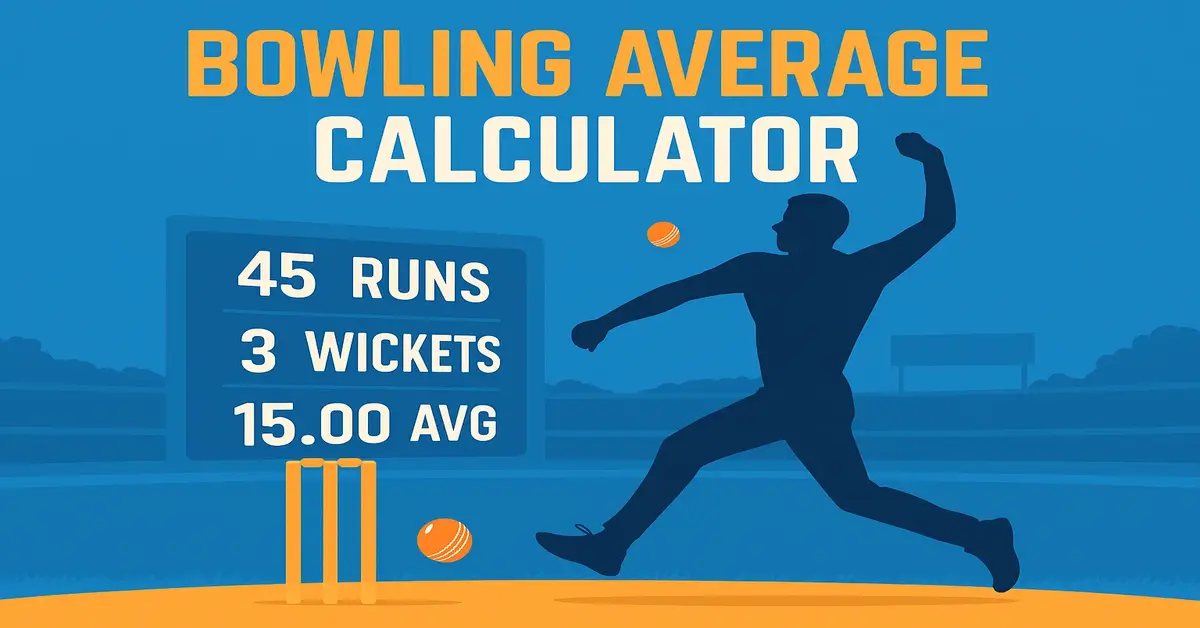Bowling Average Calculator
Curious how effective a bowler is? Use our Bowling Average Calculator to quickly calculate the number of runs conceded per wicket taken. Ideal for fans, players, and analysts who want performance insights at a glance!
Bowling Average Calculator
What is Bowling Average?
Bowling average is a key metric in cricket that measures a bowler’s effectiveness. It tells you how many runs a bowler concedes on average for every wicket they take. It is calculated by dividing the total runs conceded by the total number of wickets taken.
Formula:
📌 Bowling Average = Runs Conceded ÷ Wickets Taken
A lower bowling average generally indicates better performance, as it shows the bowler takes wickets while giving away fewer runs.
Purpose of Calculating Bowling Average
Bowling average is a crucial statistic for analyzing the consistency and impact of a bowler over a period of time. Here’s why it’s important:
- Helps compare bowlers across formats (Tests, ODIs, T20s)
- Indicates how efficiently a bowler dismisses batters
- Assists selectors, analysts, and fans in evaluating performances
- Useful for fantasy cricket and stat-based predictions
- Aids in identifying a bowler’s peak performance phase
How to Use the Bowling Average Calculator?
Using our Bowling Average Calculator is simple:
- Enter the total runs the bowler has conceded.
- Enter the number of wickets taken.
- Click on the Calculate button.
- Instantly see the bowling average.
This tool is perfect for cricket enthusiasts, fantasy league players, coaches, and analysts who want quick insights without manual calculations.
Why Bowling Average Matters for Bowlers?
Bowling average reflects a bowler’s ability to take wickets without leaking too many runs. It offers a clearer picture than just wickets alone. For example:
- A bowler with 10 wickets for 100 runs has an average of 10.
- A bowler with the same number of wickets but 300 runs conceded has an average of 30.
This simple number helps differentiate match-winners from average performers.
Top 5 Bowlers with Best Bowling Averages in Cricket History
| Player | Format | Bowling Average | Matches |
|---|---|---|---|
| Malcolm Marshall | Test | 20.94 | 81 |
| Glenn McGrath | Test | 21.64 | 124 |
| Rashid Khan | T20I | 16.9 | 85 |
| Joel Garner | ODI | 18.84 | 98 |
| Jasprit Bumrah | T20I | 19.45 | 62 |
What is Considered a Good Bowling Average?
A bowling average tells you how many runs a bowler concedes for each wicket taken. So:
- Lower average = more effective bowler
- Higher average = bowler concedes more runs per wicket (less effective)
| Format | Excellent | Good | Average | Poor |
|---|---|---|---|---|
| Test | Below 25 | 25–30 | 30–35 | Above 35 |
| ODI | Below 25 | 25–30 | 30–35 | Above 35 |
| T20I | Below 20 | 20–25 | 25–30 | Above 30 |
📌 Real Match Example of Bowling Average
E.g., In the 2019 World Cup, Jasprit Bumrah took 18 wickets and conceded 437 runs. His bowling average was 437 ÷ 18 = 24.27.
Bowling Average vs. Other Bowling Metrics
Bowling Average tells you how many runs a bowler concedes per wicket taken. It reflects both wicket-taking ability and run control.
📌 Lower average = better performance.
Bowling Economy Rate shows how many runs a bowler gives per over. It’s all about run containment, especially crucial in T20s and ODIs.
📌 Lower economy = tighter bowling.
Bowling Strike Rate indicates how many balls a bowler takes to get a wicket. It focuses on how quickly a bowler strikes.
📌 Lower strike rate = more frequent wickets.
In simple terms:
Average = runs per wicket
Economy = runs per over
Strike Rate = balls per wicket
Related Cricket Calculators
Explore more tools to evaluate a bowler’s performance across different metrics.
FAQs
Q1. What is considered a good bowling average?
A: In Tests, under 25 is excellent. In ODIs and T20s, under 30 and under 25 are considered good, respectively.
Q2. Can a bowling average be zero?
A: Yes, if a bowler takes a wicket without conceding a run, the bowling average is 0.
Q3. Why is bowling average important in Test cricket?
A: It reflects long-term consistency and wicket-taking ability over extended spells.

